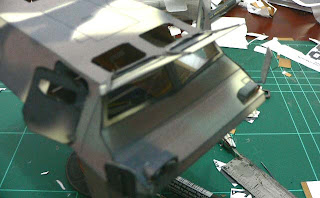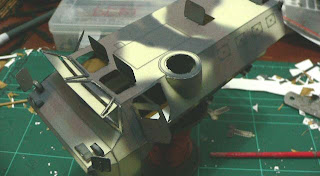the APS-3 "Anoa" (Indonesian: Angkut Personel Sedang, English: Medium Personnel Carrier) is a 6x6 armoured personnel carrier developed by PT Pindad of Indonesia. The APS-3 is named after the Anoa, which is a type of buffalo indigenous to Indonesia. The prototype was first unveiled at the 61st anniversary of TNI on October 5, 2006 in TNI HQ at Cilangkap, south of capital Jakarta.[1][2]
The Pindad APS-3 had been officially unveiled to the public at the Indo Defence & Aerospace 2008 exhibition on November 19, 2008[3] to November 22, 2008[4] after being shown in a TNI parade on October 5, 2008.[5] On August 30, 2008, 10 APS-3's have been produced[6] with the plan of having 150 vehicles to be produced for the Indonesian Army[7][8] in time for their first deployment in 2009.[9] 20 of the Pansers were handed over to the Indonesian government through the Defense Ministry, part of a deal from the initial 150 vehicles to 40 due to the economic crisis.[10] 40 Pansers were delivered as part of PT Pindad's commitment to the total delivery of 154 Pansers.[11] 33 Pansers were eventually submitted to the Ministry of Defence on January 13, 2010.[12] Pindad had received loans from state-owned Bank Mandiri, Bank BNI 46 and Bank BRI as part of payments for the manufacture of the Pansers.[10]
Development
The development history of the Pindad Panser was started in 2003 as a result of increased military intervention in the Aceh province. During the conflict, the Indonesian Army put forward urgent requirements for an armored personnel carrier for the transport of troops.
Pindad responded to this requirement in 2004, with the APR-1V (Angkut Personel Ringan)[13]Izuzu truck chassis. 14 vehicles were built by Pindad and were sent to Aceh for evaluation and combat trials. However, the follow-on orders for another 26 vehicles were canceled following the 2004 tsunami. a 4x4 armored vehicle based on a commercial
Pindad continued the APC development program with assistance from the Agency For Assessment and Application of Technology or BPPT in 2005.[14] The next prototype was the APS-1 (Angkut Personel Sedang), a 6x6 design that was again based on a commercial Perkasa truck platform by PT Texmaco.[15] Although it was not selected for production, the experience gained in developing the APS-1 convinced the Indonesian Army to give the go-ahead by Pindad to develop the next generation of Panser vehicles, the APS-2 at a production cost of 600 million rupiah or US$60,000 each.source
well this one it's very special for me, over one year to completed just I can't found the right timing and feel...yup got to fix it out now...here some late 3d progress



































































